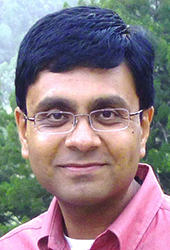Software created to help find a cure for a "great neglected disease"
SF State-led team's software determines drugs' effectiveness in treating schistosomiasis
SAN FRANCISCO, Jan. 12, 2015 -- For decades, scientists around the world have worked to develop a treatment for schistosomiasis, a debilitating water-born parasite that affects more than 200 million people worldwide. To aid this research, Rahul Singh, professor of computer science at San Francisco State University, has developed software that solves the key challenge of quantitatively assessing the impact of a drug on the parasite. Singh and his team recently completed and made public the Quantal Dose Response Calculator (QDREC), software that analyzes images showing the effects of potential drugs on parasites and quantifies their effectiveness. A description of the software was published online in Bioinformatics (Oxford University Press) on Dec. 24, 2014.

Professor of Computer Science Rahul Singh
QDREC is designed to streamline the screening stage of the drug-discovery process, during which possible drugs are first identified. Traditionally, after introducing a chemical compound to a parasite, a scientist is required to meticulously document and analyze changes. The subjective and low-throughput nature of this process -- requiring highly trained scientists to study, one by one, the effects of a potential drug -- is one of the major barriers to breakthroughs, Singh said. "You are doomed to only a trickle of advancements," he added.
"The thought came to my mind to try to use computational and algorithmic ideas to do something that humans can't do yet, which is to automate the process of the parasites being exposed to the drug," Singh said. "The biologist or chemist would capture images or videos of what happens to the parasite, then the computer would analyze the images automatically and, at the end of the process, the computer would come up with a single measurement that would quantify whether the compound is effective."
For the past six years, Singh and his team of students have developed many of the algorithmic solutions that comprise QDREC. The software is now available for parasitologists, biologists and other drug developers around the world to use -- free of charge -- in the quest to find a cure for schistosomiasis.
Endemic in parts of Sub-Saharan Africa, South America and Southeast Asia, the parasite -- which Singh describes as the cause of a "great neglected disease" -- lives in fresh water and penetrates a person's skin when they enter the water. It can remain inside the body, reproducing, for decades. Symptoms, caused by the body's reaction to the worms' eggs, can include abdominal pain, liver enlargement and kidney damage. Children who are infected often develop learning difficulties.
Beyond causing physical pain and suffering, schistosomiasis creates an unfortunate domino effect, Singh explained. "Typically, poor people have to use water infected with this parasite, then they catch this debilitating disease, so it impacts them economically," Singh said. "It's a vicious circle of poverty, and it goes from bad to worse."
While a drug, called praziquantel, does exist to treat the disease, Singh pointed out, using a single drug to treat millions of people across a large area over decades carries a high risk of the parasite building resistance. For that reason, the World Health Organization has designated the discovery of new therapies for schistosomiasis an urgent need.
Nonetheless, Singh said that the commercial drug discovery sector has typically neglected such diseases -- even though they affect a large percentage of humankind -- because most of the infected people are poor. "People who suffer from these diseases do not carry credit cards, so it would not fit the business models of pharmaceutical companies to try to pursue these diseases -- they would not make enough money to recoup their research and development costs," Singh said.
But Singh said that he is optimistic that QDREC will help make it possible to find an effective treatment for schistosomiasis. "This parasite has been studied since the 1800s, but until last month the kind of results obtainable with QDREC were not possible," Singh said. "Now scientists can screen a large number of compounds, upload the data, press a button, and in a few moments they will have an answer as to which are efficacious -- something that before could take months or years."
"The QDREC webserver: Determining dose-response characteristics of complex macroparasites in phenotypic drug screens" was published online in Bioinformatics on Dec. 24, 2014, and will be printed in the journal in 2015. Co-authors include Daniel Asarnow of San Francisco State University and Liliana Rojo-Arreola, Brian M. Suzuki and Conor R. Caffrey of the University of California, San Francisco.
###
SF State is the only master's-level public university serving the counties of San Francisco, San Mateo and Marin. The University enrolls nearly 30,000 students each year and offers nationally acclaimed programs in a range of fields -- from creative writing, cinema, biology and history to broadcast and electronic communication arts, theatre arts and ethnic studies. The University's more than 228,000 graduates have contributed to the economic, cultural and civic fabric of San Francisco and beyond.